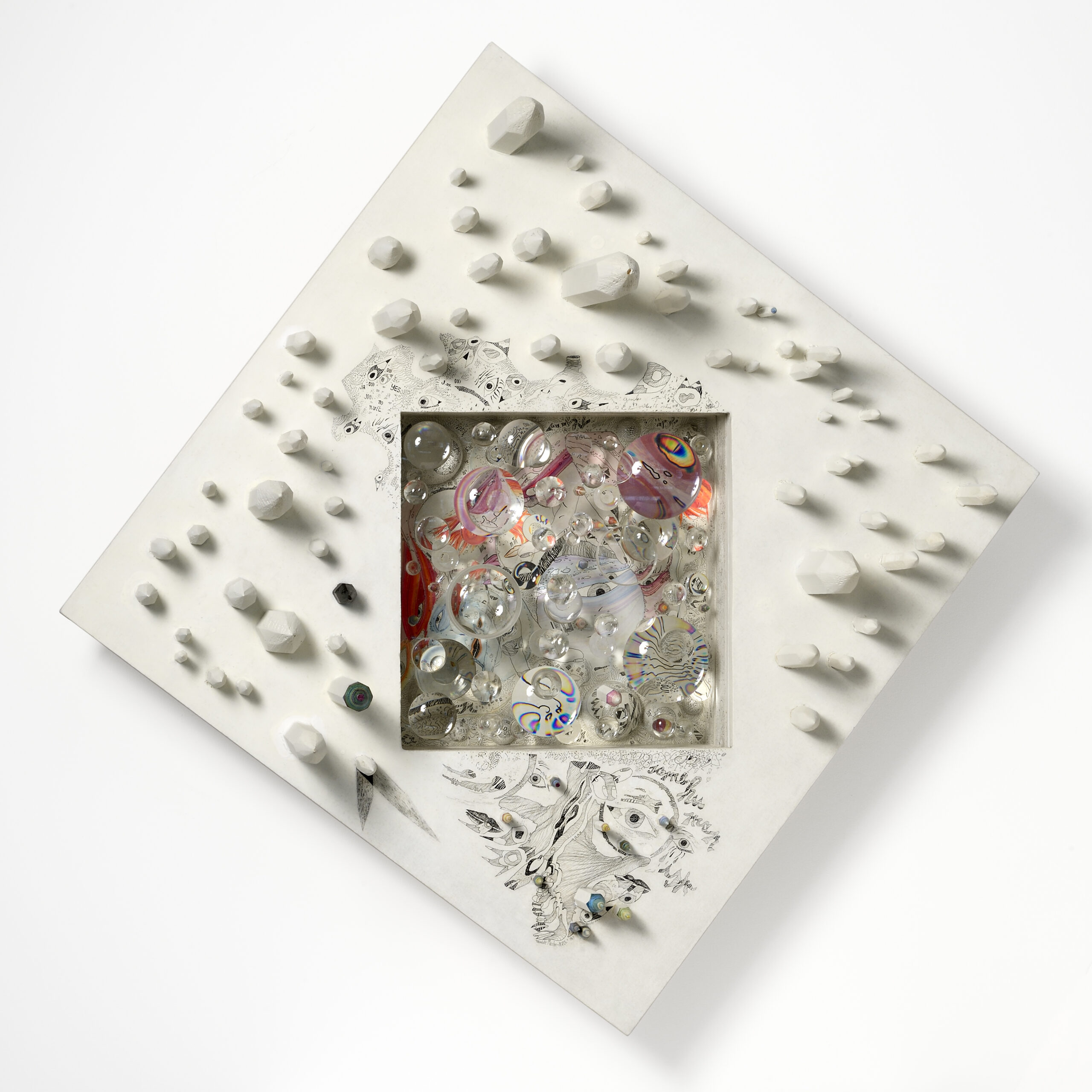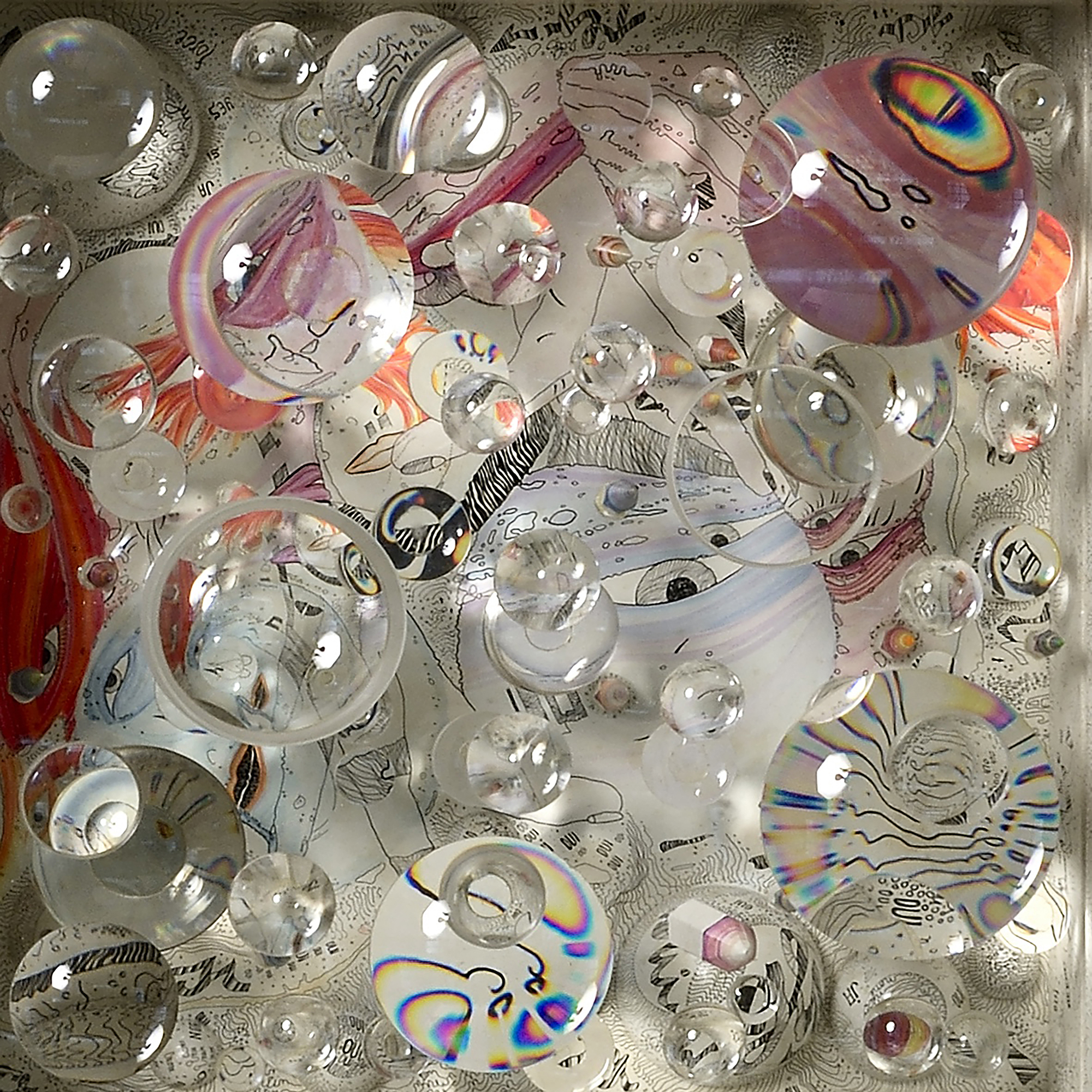MARY BAUERMEISTER
THE BIRTH OF A LENS BOX – HOW EVERYTHING STARTED
Mary Bauermeister (1934-2023) is considered a pioneer in interdisciplinary and conceptual art. Her lens boxes are a significant example of her ability to combine visual and optical elements to create artworks that challenge and engage the viewer in new ways. These works also reflect the influence of other artistic movements of the time, such as Fluxus, of which Bauermeister was a central figure.
One of her most famous pieces are the lens boxes, a three-dimensional works that incorporate magnifying lenses and other transparent or semi-transparent objects within box-like structures. These boxes create a unique visual effect, inviting the viewer to look through the lenses and explore the images and materials inside them in new and unexpected ways.

Mary in N.Y, 1965
WATCHMAKER’S LENSES
In 1961, after meeting Jan Willem Sandberg, who led Mary’s first exhibition at Stedelijk Museum, she was very excited to prepare the show. She had approximately six months to do so.
One day she happened to enter an antique shop, where a widow of a watchmaker had placed on sale all the optical lenses of her husband. She spent all of her money, earned through a stage design, to buy them. The artist experimented with the glass of various shapes and different focus and width, and had a lot of fun looking through them and observing natural and artificial things. The intent was to share the joy of the discovery with the spectators. This was the beginning of a lifetime artistic research, that would inspire the creation of a multitude of artworks.
“Lenses distort and magnify, creating layers of meaning. They force us to look closer and think deeper about what we see.”
FIRST LENS BOXES
In 1962, Mary created her first lens box, placing loose lenses on the glass. The problem was that people stole the lenses during the openings, thing that actually happened in 1964 at her first American show Mary Bauermeister – Paintings and Constructions at Galleria Bonino in New York. From that moment on, Mary started to glue the lenses on the top glass layer, a decision that opened up a world of possibilities for her. She was able to hang the boxes vertically on the wall and play with optical metamorphosis of visual perception of the reality. In fact, the work underwent continuous changes that depended on the viewer’s perspective, who, by moving, could discover multiple possibilities of the same work.
In fact whatever she wrote or painted on the background of the box became ambiguous thanks to the use of the lenses. Mary wanted people to use their mind and to loosen up their opinions. The consciousness for the artist is an ever changing process and it shouldn’t have dogmas, that are the reason why there are wars and there is no peace. As Mary said in her interview with Hauke Ohls in 2016, “The statement that oscillates and changes, facing a contrary statement, becomes tolerant and more peaceful, and it is never aggressive. You can believe in it or not, it is nonsense anyway. In this regard, art is nonsense for sure…it is feeling, it is thinking, it is searching, and it has so many ways. When it is dogmatic, for me it is less art.”

Nicky Saint Phalle and Tinguely playing with Poeme optique at exhibition at Galeria Bonino, New York 1964
“I am fascinated by how our perception shapes our understanding of the world. The Lens Boxes are a way to play with that idea, to show that reality is not fixed but fluid and multi-layered.”
THE STORY BEHIND ABSOLUTE MASTER PIECE/PEACE
“Absolute Master piece/peace” is an important work created by Mary Bauermeister in 1969. This artwork reflects Bauermeister’s deep engagement with themes of perception, reality, and the intersection of art and social issues.
The title plays with a conceptual duality that suggests a connection between the idea of a perfect work of art (“Masterpiece”) and the broader, perhaps more abstract concept of “Peace.” This duality invites viewers to contemplate the relationship between artistic creation and societal ideals. Beyond this duality, there is another one that compares femininity to masculinity. In fact, the spheres, the lenses and the wooden pencils glued on the rhomboidal frame have their own specific meaning. The part that is introverted, the square box, represents a female uterus containing eggs and has a beautiful kitschy colors. The male element is represented by the pencils on the frame. The painted part of the frame serves as a sort of connection between the two. The work tries to respond to how to keep back our aggression and not to fight against each other. It is an invitation to find a balance between the complexity of our feelings and beliefs.
On the lower left side, Mary painted two shadows overlapping each other. Her creative process in painting shadows involved a lamp, which she used to illuminate the pencil from different perspectives, creating a multitude of shadows. The concept of the big or small shadow, that always depends on the light and not on the dimension, is another link to the thought that not everything is as it seems.


